
Last updated:
Typhoon Haiyan

Overview
One of the strongest storms to ever make landfall, Typhoon Haiyan (Yolanda) cut across nine regions in the central Philippines on November 8, 2013, leaving behind a wide swath of destruction.
The storm was a category 5, with wind gusts up to 235 miles per hour, causing massive landslides and flooding. The storm caused 6,300 deaths, injured at least 27,665, displaced more than 4.1 million, and destroyed more than a million homes. To date, at least 1,785 are still categorized as missing, according to the Republic of Philippines government.
(Photo: Nerissa Cumpio at the site of her destroyed clinic following Typhoon Haiyan. Source: Mercy in Action)
The worst areas affected by Haiyan have stabilized and transitioned to the recovery phase. Humanitarian assistance is still required, particularly in the areas of food, clean water, shelter, and basic healthcare. The Philippine government launched an $8.2 billion, 4-year plan focused on rebuilding areas destroyed by the storm and developing resilience and mitigation measures for future disasters. A response plan, coalescing United Nations organizations, nongovernmental organizations and international responders, was launched following the storm to support recovery efforts.
The most pressing needs in areas affected by Haiyan are permanent shelter and housing; livelihood recovery; health care; and food security.
Sources: USAID, NHK World, BBC, OCHA, CNN and responding NGOs.
Latest Updates
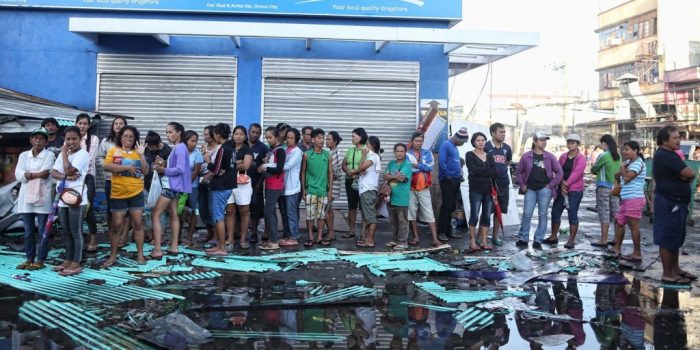
Haiyan Recovery Still Has Long Road Ahead
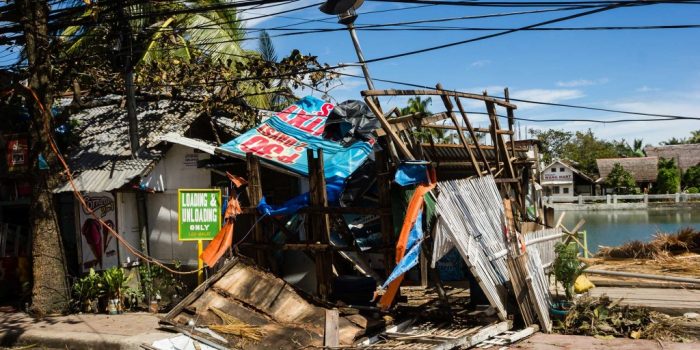
Life after a Super Typhoon
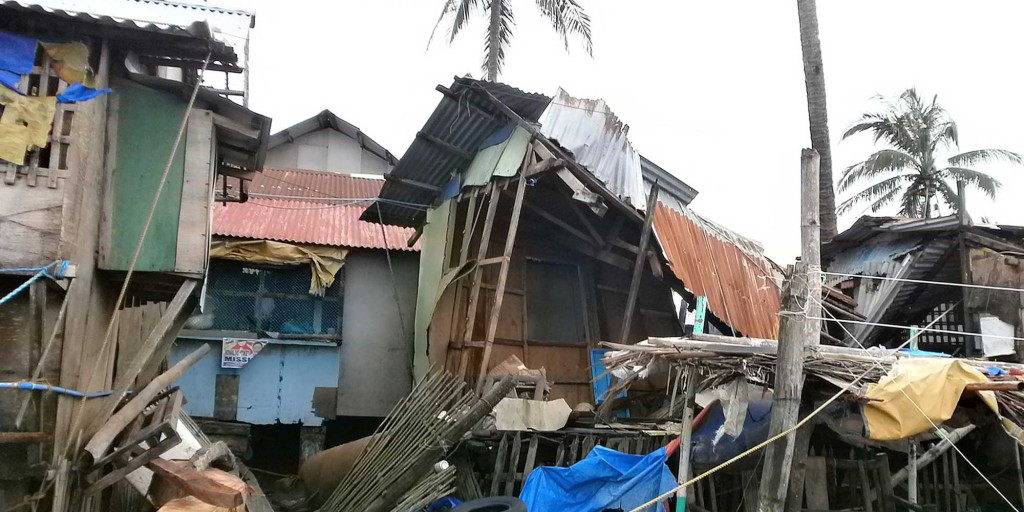
CDP Typhoon Haiyan Recovery Fund Fills Recovery Gaps
What was the impact on the community?
Typhoon Haiyan, locally known as Yolanda, made initial landfall in Eastern Samar, Philippines on November 8, 2013. The storm tracked across the Visayas region, bringing high winds, torrential rain and storm surge, ultimately impacting up to 16 million people. Unable to communicate due to loss of power and phones, it took days, even weeks, to reach certain parts of the country to assess the damages. Reports confirm that more than 6,000 people have died and as many as 1,800 are missing.
Following the storm, severe damages to properties and infrastructure were been reported. Electric posts and trees blocked roads; buildings and houses, especially those of light materials, were flattened.
Typhoon Haiyan roared onto Samar at 4:30 a.m., flooding streets and knocking out power and communications networks in many areas of the hilly island in the region of Eastern Visayas, and then continued its march, barreling into four other Philippine islands as it moved across the archipelago.
With sustained winds of 315 kph (195 mph) and gusts as strong as 380 kph (235 mph), Haiyan may be the strongest tropical cyclone to hit land anywhere in recorded history.
The day prior to the storm making landfall, thousands of people evacuated villages in the central Philippines. Authorities warned people in provinces across the country to prepare for possible flash floods, landslides and a storm surge as high as 7 meters (23 feet). About 125,000 people nationwide were moved to evacuation centers. However, many of those safe spaces were schools that could not sustain winds above 99 mph.
Among the most vulnerable were people living in tents on the central Philippine island of Bohol, where a 7.1-magnitude earthquake hit last month, killing at least 222 people, injuring nearly 1,000 and displacing about 350,000, according to authorities. On Friday, Bohol got a second jolt — this time from the typhoon’s winds and rain, but they were spared a direct hit.
Overall, Philippines officials, who pride themselves on planning and preparation, had no idea that the storm would reach such magnitude. And the high rising tides, which do not always accompany typhoons, revealed itself much like a tsunami.
A season of challenges
The Philippines is an island nation of 96 million people living at the doorstep of climate change. Each year, Filipinos face recurring natural disaster, enduring typhoons, severe drought, floods and coastal erosion.
The year brought with it back-to-back events, with Tropical Depression Shanshan arriving in February and impacting 80,000 families, many of whom were still recovering from Typhoon Bopha, which occurred in 2012. Subsequent tropical depressions, typhoons, and monsoons occurred with regularity, taking hundreds of lives and leaving tens of thousands without homes.
The 7.1 magnitude earthquake on Oct. 15, 2013, in Bohol province killed 222 people and injured 976. Eight people are still missing. Over 344,300 people were displaced with 80 percent living in makeshift shelters built in open spaces near their damaged houses. Just two weeks later, Typhoon Krosa made landfall on Oct. 31, 2013, causing four deaths, and damaging 32,000 homes and 6.3 million in crops.
Facts and stats

- Typhoon Haiyan is one of the strongest typhoons ever recorded, and is estimated to have destroyed about 70 to 80 percent of structures in its path.
- The Philippines is hit by an average of 19 typhoons a year.
- There are more than 6,000 confirmed deaths and 1,800 people are missing due to the storm.
- 16 million people were affected by Typhoon Haiyan in nine regions across the Philippines, and close to four million people were displaced.
- More than one million homes were damaged or destroyed.
- 22 countries, including the United States, have offered aid.
- Just prior to Typhoon Haiyan, a 7.2 magnitude earthquake struck Bohol province in central Philippines on Oct. 15, 2013, killing 222 people, and injuring 976 with 8 still missing.
- The Philippines is one of the world’s largest exporters of coconuts, and at least 33 million coconut trees were destroyed in the storm. Newly planted coconut trees take six to eight years to mature.
- The damage to the coconut- and rice-growing region from the storm is expected to amount to more than 3 billion pesos ($69 million).
- Typhoon Haiyan damaged about 30,000 small-scale fishing boats and about 100,000 boats were lost or destroyed.
- There is an estimated 1,000 births every day in storm-affected areas, and there is a significant shortage of reproductive health options in most areas.
Five months after Typhoon Haiyan, known locally as Yolanda, shelter remains a pressing issue. USAID estimates that 36 percent of families affected by the storm continue to live in evacuation centers, tent cities, and spontaneous settlements.
Food
Food security continues to be a significant problem. Much of the agricultural area and crops were destroyed by the storm. Coupled with the loss in markets, equipment, and people from the food production network, there is a great instability in food supply.
Fishing and agriculture
The storm had a significant economic impact on the Philippines. The disaster impacted more than 4 million livelihoods. Those in the Philippines relying on fishing or agriculture for their livelihood suffered significant losses that will take months to recover from. Many of those relying on fishing lost boats and equipment in the storm. The Philippines was the world’s largest exporters of coconuts. Typhoon Haiyan damaged an estimated 33 million coconut trees, which affected more than one million farmers. Other agricultural losses included crops and livestock. Due to the storm, many small farms were unable to plant in December, which further reduces the amount of available food in the coming year. In addition, the dislocation of farmers and fishermen has made restarting these livelihoods more difficult.
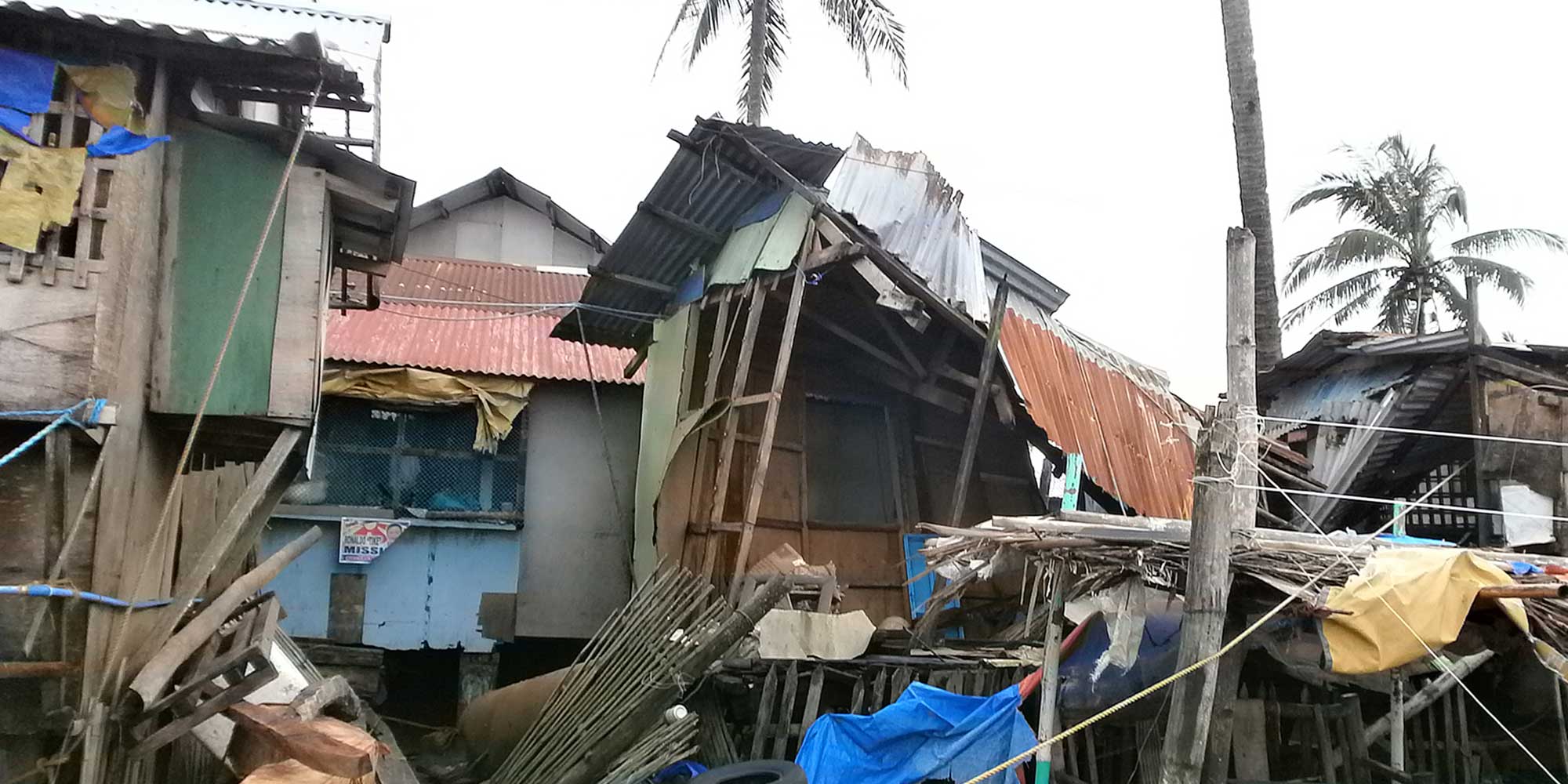
As with most disasters, experts recommend cash donations. They allow on-the-ground agencies to direct funds to the most significant area of need, support economic recovery and ensure donation management does not detract from disaster recovery needs.
Contact CDP
Recovery updates
If you are a responding NGO or a donor, please send updates on how you are working on recovery from this disaster to Tanya Gulliver-Garcia.
Donor recommendations
If you are a donor looking for recommendations on how to help with disaster recovery, please email Regine A. Webster.
Philanthropic and government support
Donors
Data provided by The Foundation Center, and self-reported by funders.
- Accenture, $1 million, to Plan International.
- Aramark Corporation, $50,000 to American Red Cross.
- Bank of America, $250,000 to American Red Cross and Save the Children.
- Carlson Family Foundation, $10,000 to American Red Cross and International Rescue Committee, $25,000.
- Colette Foundation, $25,000 to Plan International.
- EMC Corporation Contribution, $100,000 to Give2Asia.
- Fast Retailing, $103,316 to UNICEF.
- Health Net Foundation, $50,000, American Red Cross.
- Horizon Charitable Foundation, $50,000 to various NGOs.
- Hyundai Heavy Industries, Inc., $200,000, to Korean Red Cross.
- Island Insurance Foundation, $25,000 to the Filipino Community Center. The organizations is also partnering with the Consuelo Foundation in a dollar-for-dollar match of up to $2 million.
- JCB Corporate Giving Program, $500,000 to Direct Relief.
- Kaiser Permanente’s Corporate Giving Program, $100,000 to American Red Cross and $25,000 each to Doctors Without Borders, Mercy Corp, Relief International, and Team Rubicon.
- Kohl’s Corporation Contributions Program, $50,000 to American Red Cross.
- MasterCard Incorporated Corporate Giving Program, $100,000 to American Red Cross and $100,000 to World Food Programme.
- Monsanto, $100,000 each to American Red Cross, Save The Children and International Rescue Committee. For long-term recovery Monsanto has provided $400,000 to help Filipino farmers access food and water and to rebuild and repair farmers’ homes. The company is also donating seeds to farmers. The company has 100 employees in the area and has worked there for decades.
- The Moody’s Foundation, $50,000, to American Red Cross.
- The Pfizer Foundation, $250,000 each to UNICEF and World Vision.
- The Travelers Companies, Inc. Corporate Giving Program, $100,000 to American Red Cross.
- Tyson Foods, Inc. Corporate Giving Program, $100,000 to World Food Programme.
- United Health Foundation, $750,000 to Project Hope.
- Xylem Watermark, $100,000, to Mercy Corp and Planet Water.
NGO Response
- Action Against Hunger With extensive experience working across the Philippines since 2000, Action Against Hunger’s on-the-ground experts were able to mount an immediate post-typhoon emergency response, carrying out needs assessments while preparing distributions of drinking water and survival kits containing buckets, soap, and chlorine tablets. With reinforcements of emergency personnel and material arriving on external flights, Action Against Hunger’s teams have set up mobile water treatment plants, massive “bladders” for distributing clean water, and emergency pumps and filtration systems to ensure access to water.
- Adventist Development and Relief Agency (ADRA) has implemented projects to provide shelter, water/sanitation, and food to the victims of Typhoon Haiyan.
- The American Refugee Committee (ARC) provided emergency shelter kits and non-food items such as plastic sheeting, blankets, cooking utensils, and water containers. Teams continue to assist recovery efforts with food and water supplies, along with shelter materials for rebuilding and seeds for livelihood rebuilding.
- All Hands launched Project Leyte. Hundreds of volunteers have logged hours with Project Leyte, working to clear debris, rebuild homes, schools, and community buildings; and distribute food relief supplies.
- The American Jewish Joint Distribution Committee (JDC) shipped a container of food, shelter, hygiene and medical supplies to the Philippines. The non-profit is also providing “School in a Box” kits for temporary classrooms for displaced children through its ongoing partnership with UNICEF.
- Americares: AmeriCares is working meet the health needs of families suffering in the aftermath of Typhoon Haiyan. Response to date includes more than $7.1 million in medical and humanitarian aid to partners working in the hardest hit areas :$6 million in emergency medical aid: medicines and medical supplies, antibiotics, bandages, nutritional supplements, blankets and other relief supplies; $250,000 in emergency funding: for project support, and to procure relief supplies and humanitarian aid for survivors in need.
- Architecture for Humanity has been in close communication with local architects and its Manila Chapter, as well partners within its network, with a focus on creating plans for the reconstruction of resilient homes and buildings.
- Build Change will work with local partners to identify the most critical rebuilding needs in the typhoon-affected areas in the Philippines and complete a forensic engineering study to determine reasons for building collapses. We will then design disaster-resistant houses based on local designs, materials and practices, and train homeowners, builders, engineers and government officials to build them.
- Catholic Relief Services has been active in the Philippines for decades and responded to Haiyan with shelter materials and a focus on water and sanitation.
- CBM has a regional office in the Philippines. The emergency response unit is working closely with the regional office and the 10 partners located in the path of typhoon Haiyan.
- CARE is working with partners to deliver emergency relief in three areas of the Philippines: Leyte, Samar and Panay. Our target is to reach 200,000 people with lifesaving food, shelter, other assistance, and help communities recover in the months and years to come. So far, CARE has provided food to more than 88,000 people, and shelter materials (shelter kits and tarpaulins) and kitchen sets to more than 15,000 individuals.
- ChildFund International completed rapid assessments, and its response is focused on the areas of Ormoc City, Tacloban City, Palo and Tolosa in Leyte, Bantayan Island in Northern Cebu and Roxas City in Capiz. Relief has focused on the supply food and water, blankets, shelter and other emergency aid to children and families.
- Convoy of Hope To date, more than 1.3 million meals have been distributed in the Philippines. In all, approximately 3,000,000 meals as well as relief supplies such as water filters, hygiene products and tents are earmarked for the Philippines. Convoy of Hope is partnering with several agencies and missionaries to build 100 homes on the island of Malapascua.
- Doctors Without Borders/ Médecins Sans Frontièresis providing medical and humanitarian assistance on three islands that were battered by the typhoon. MSF supports hospitals in Tacloban and Burauen (on Leyte Island), Balasan (on Panay Island), and Guiuan (on Samar Island) with the aim of helping to restore normal medical services as quickly as possible. The support includes repairing damaged buildings; providing medical supplies, drugs and staff; and setting up an ambulance service.
- Direct Relief continues to deliver medical aid to a number of hospitals and health facilities throughout the Philippines.
- Habitat for Humanity response efforts included the distribution of 50,000 cleanup and hygiene kits for immediate relief and 30,000 shelter repair kits to help families make needed repairs to partially damaged homes for safety and security. Teams continue to work in affected areas, following Habitat’s model of assisting affected communities from emergency shelter interventions through to permanent home reconstruction.
- Heifer International is working with local organizations and the local government to provide relief to the 4,000 project members affected by Typhoon Haiyan. Development work has focused on helping farmers overcome poverty permanently and grow resiliency against disasters.
- International Medical Corps: provided medical services through 10 mobile medical units (MMUs) in some of the hardest-hit areas following Typhoon Haiyan. International Medical Corps is also conducting water, sanitation and hygiene (WASH) screenings; medical and mental health assessments in affected communities; and has begun nutrition screening and treatment referral for children. By working through MMUs, International Medical Corps has been able to provide critical health services on remote islands where families struggle to access medical care and basic resources.
- International Rescue Committee: The International Rescue Committee is on the ground in the Philippines focusing on urgent water, sanitation, hygiene and health needs — along with programs that will put some money back into people’s pockets and help to revitalize the local economy.
- Lutheran World Relief (LWR) Philippines was on the ground working with local partners to mobilize resources for those in need following Typhoon Haiyan. Initial emergency relief projects included distribution of shelter repair kits in northern Cebu Province’s Daanbantayan municipality, as well as provision of community water filtration units and needed non-food items. LWR implemented cash-for-work (CFW) activities focused on debris removal in areas of northern Cebu and western Leyte provinces. LWR continues to work on long-term recovery in shelter, non-food items and material resources, WASH, and livelihoods.
- MedShare International is equipping Medical Mission teams that are on the ground delivering medical care to the survivors of Typhoon Haiyan. MedShare Medical Mission (MedTeam) Stores equip teams of health care professionals with low-cost, high-quality medical supplies.
- Mercy Corps supplied food and hygiene kits, along with blankets and other items to those affected by the storm. In January 2014, Mercy Corps shifted its focus to long-term economic recovery, partnering with BanKO, a Philippine micro finance bank, to make small cash grants to typhoon survivors.
- Mercy in Action went to work immediately to assist pregnant women in the areas hardest hit by the storm. The organization has shifted its focus to long-term needs by working to rebuild a birth center that will serve the needs of hundreds of women and their infants.
- Oxfam is distributing food and water supplies, along with hygiene kits; and working to support the rebuilding of livelihoods and business.
- Plan International: Plan is supporting basic maternal, newborn and child health/nutrition interventions at health facilities. Child Friendly Spaces are currently being established in Leyte, with 40 additional CFS kits in transport now for dispatch to Eastern Samar and Leyte. Plan is working actively with the UN cluster on the identification, registration, and reunification of separated and unaccompanied children.
- Project C.U.R.E. has sent six 20-foot, disaster relief containers of medical supplies to the Philippines. The containers had approximately $3,727,973.66 worth of medical equipment and supplies..
- Project HOPE has airlifted $1 million worth of medicines and medical supplies, and raised $1.4 million in cash donations from corporate and foundation partners and individual donors in support of the Typhoon Haiyan relief effort.
- The Red Cross continues emergency assistance that already has reached more than 1.3 million people. Emergency relief distributions of food, clean water, supplies and other items to affected communities are complete and the Red Cross is now moving forward with longer term recovery projects. The Red Cross has given more than 59,000 families cash grants to help address storm-related needs, such as shelter and seeds for the planting season. The American Red Cross has spent or committed $56.8 million on the response for Typhoon Haiyan and will make additional financial commitments in the months to come.
- Save the Children: has focused on sheltering children and families; providing water; health services; and helping children return to school.
- Shelter Box is focusing on providing emergency tented shelter, water filters, blankets, toolkits, solar lights and other non-food items to families impacted by the Typhoon Haiyan. The items are meant to help families live independently and with dignity as they rebuild their lives and communities.
- The Tzu Chi Foundation brought relief supplies to affected survivors and launched a cash for work program to help clean up devastated areas.
- UNICEF: The Back to Learning campaign for 500,000 children in typhoon-affected areas has been organized under the name balik eskwela (‘back to school’ in the Waray language) and is led by the Department of Education and the Department of Social Welfare and Development, with the support of UNICEF and International and national NGOs and other local partners. A ‘soft opening’ of schools took place on December 2 for schools that were ready to start informal classes. Since December, UNICEF has begun providing learning and recreational materials for 500,000 children, putting in place 3,000 temporary learning spaces, and water and sanitation facilities for 1,000 schools.
- World Vision: World Vision’s WAYCS (Women and Young Children Space) locations in the Philippines are part of the organization’s long-term response to the devastation of Typhoon Haiyan in November. The strategically-located spaces provide mothers and young children with a setting to spend time with each other and receive support from trained volunteer health workers. Each of the 13 locations offer assistance for breastfeeding mothers and nutritional monitoring for incoming children. World Vision also operates 34 Child-Friendly Spaces in the Philippines — places where disaster-affected children can play, learn, and talk about their experiences in a supportive environment.
Take Action

- Fund programs that support mental health. Counseling and other support services are needed and too few professionals are able to provide support.
- Fund programs to meet immediate needs.With so many people displaced from the string of tropical depressions, typhoons and the earthquake, water, sanitation, and hygiene are tremendous concerns. With agriculture severely impacted, many families have serious food insecurity. The need for temporary shelter remains great.
- Establish/strengthen the nation’s evacuation centers. As the world’s third most disaster-prone nation, the Philippines encounters numerous events each year.
- Agriculture was severely damaged, and in many areas—such as banana plantations—it will take years to recover. Mitigation efforts as well as targeted investments will be needed to help improve livelihoods for years to come.
- Fund environmental efforts to protect and improve coral reefs in coastal areas. The World Disaster Report 2012 reported that the Philippines could protect about a fifth of its population by improving protection of coral reefs. They are a primary line of defense against coastal hazards like typhoons.
- Support programs that provide psychosocial assistance. In the initial days after 2012’s Typhoon Bopha, the United Nations reported that many adults were unable to assist in recovery efforts because of the shock of the event. Children were left unattended, crying and begging at the roadside.
- Support mid-to long-term recovery: After immediate relief is handled, the people in the Philippines will need support for many years to come. Rebuilding homes, businesses and infrastructure is a long and arduous process. Consider donating to the CDP Haiyan Recovery Fund.
We welcome the republication of our content. Please credit the Center for Disaster Philanthropy.
Fund resources
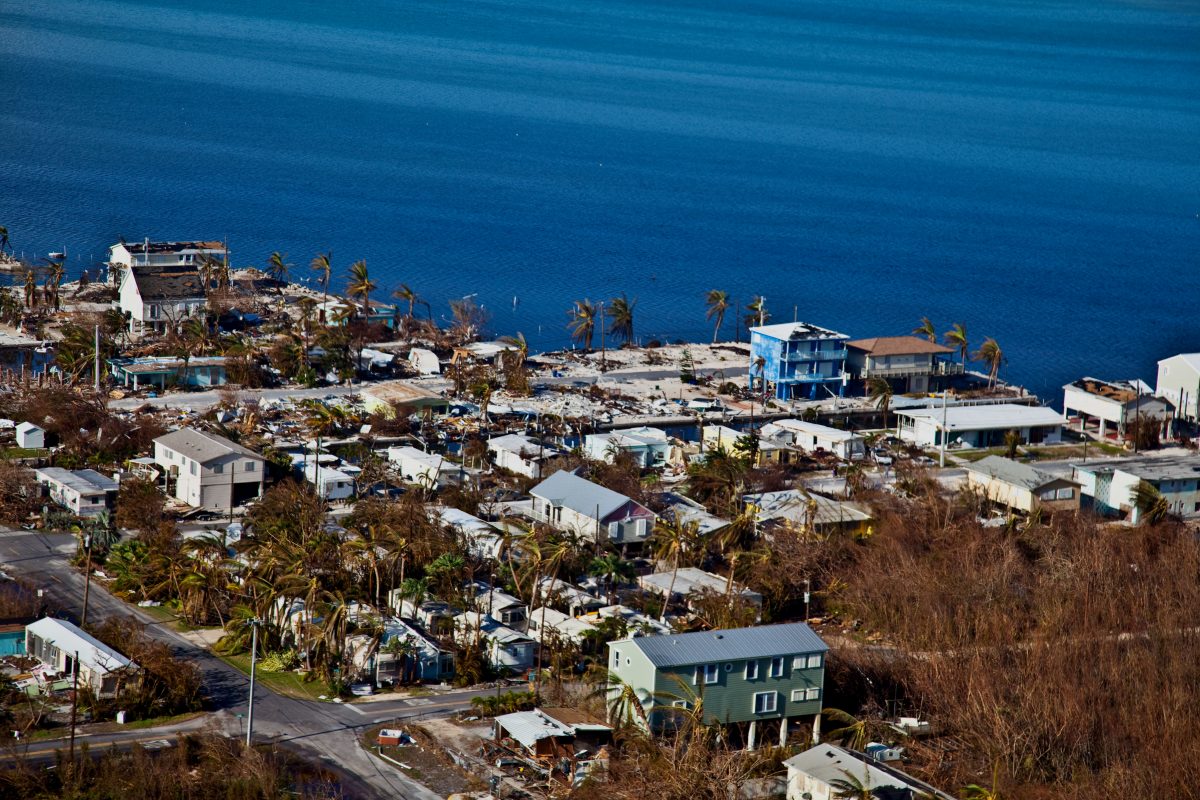
Hurricanes, Typhoons and Cyclones
Tropical cyclones (also known as hurricanes and typhoons) pose significant global threats to life and property, bringing a variety of hazards, including storm surges, flooding, extreme winds and tornadoes. Funders can intervene to reduce harm to people and property, before, during and after storms.

Is your community prepared for a disaster?
Explore the Disaster Playbook